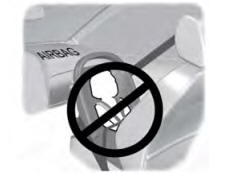Ford Explorer: Hydraulic Brake Actuation / Removal and Installation - Remote Brake Fluid Reservoir
Ford Explorer 2020-2025 Service Manual / Chassis / Brake System / Hydraulic Brake Actuation / Removal and Installation - Remote Brake Fluid Reservoir
Removal
NOTICE: Siphon the brake fluid from the HCU/EBB reservoir, if the reservoir is not emptied there will be a large amount of brake fluid spilled in the engine compartment.
NOTE: Removal steps in this procedure may contain installation details.
-
Remove the cowl panel grille.
Refer to: Cowl Panel Grille (501-02 Front End Body Panels, Removal and Installation).
-
Release the tabs and remove the BCMC cover.
.jpg) |
-
-
Remove the nut and position aside the cable aside.
Torque: 106 lb.in (12 Nm)
-
Fully loosen the BCMC connector bolts.
Torque: 48 lb.in (5.4 Nm)
-
Remove the nut and position aside the cable aside.
.jpg) |
-
Release the tabs and remove the BCMC.
.jpg) |
-
Remove the bolts, detach the wiring retainers and then remove the BCMC support bracket.
Torque: 106 lb.in (12 Nm)
.jpg) |
-
https://magicaliptv.com/iptv-free-trials/
NOTICE: If the brake fluid is spilled on any component, the affected area must be immediately washed down with cold water.
NOTE: Be prepared to collect escaping fluid.
Disconnect the remote brake fluid reservoir tube and drain the fluid into a suitable container.
.jpg) |
-
Remove the 2 bolts and the remote brake fluid reservoir.
Torque: 25 lb.in (2.8 Nm)
.jpg) |
Installation
-
To install, reverse the removal procedure.
-
Remove the remote brake fluid reservoir cap.
.jpg) |
-
If provided with the service kit.
Replace the translation label.
.jpg) |
-
Fill the reservoir with clean, specified brake fluid.
Refer to: Specifications (206-00 Brake System - General Information, Specifications).
.jpg) |
 Removal and Installation - Brake Pedal and Bracket
Removal and Installation - Brake Pedal and Bracket
Removal
NOTE:
Removal steps in this procedure may contain installation details.
Remove the BCM.
Refer to: Body Control Module (BCM) (419-10 Multifunction Electronic Modules, Removal and I..
Other information:
Ford Explorer 2020-2025 Service Manual: General Procedures - Washer Hose Coupling
Disconnect WARNING: Before beginning any service procedure in this section, refer to Safety Warnings in section 100-00 General Information. Failure to follow this instruction may result in serious personal injury. Refer to: Health and Safety Precautions (100-00 General Information, Description and Operation)...
Ford Explorer 2020-2025 Service Manual: Removal and Installation - Ignition Lock Cylinder Housing
Removal NOTE: Removal steps in this procedure may contain installation details. Release the clips and remove the instrument panel upper finish panel and the ignition lock cylinder housing. Disconnect the electrical connectors...
Categories
- Manuals Home
- 6th Generation Explorer Owners Manual
- 6th Generation Explorer Service Manual
- Removal and Installation - All-Wheel Drive (AWD) Module
- Description and Operation - Identification Codes
- Using Tether Straps
- New on site
- Most important about car
Children and Airbags
WARNING: Airbags can kill or injure a child in a child restraint. Never place a rear-facing child restraint in front of an active airbag. If you must use a forward-facing child restraint in the front seat, move the seat upon which the child restraint is installed all the way back.

Copyright © 2025 www.foexplorer.com

